
Key takeaways
Australia’s residential real estate total market value rose to $12.2 trillion in November.
National dwelling values rose 3.1% over the quarter and 7.5% annually, adding an estimated $61,690 to the median Australian dwelling value.
As of December 10th, rolling 28-day growth shows Perth, Adelaide and Brisbane lifting between 1.7% and 2.2%, while Sydney and Melbourne growth has slowed to 0.1% and 0.2%.
Cotality estimates that more than 550,000 sales have transacted in the year to November, a 3.3% increase on the same time last year and 5.5% higher than the five-year average.
Median time on market rose to 27 days nationally, with capital city homes selling fastest in Perth (nine days) and slowest in Canberra (36 days) and Darwin (37 days).
While new listings have trended roughly in line with historic averages since mid-September, total advertised stock nationally is 14.0% lower than a year ago and remains 18.3% below the five-year spring average.
New listings in Hobart, Sydney and Melbourne are up 18.4%, 11.9% and 11.2% respectively compared to this time last year, while Perth’s flow of newly advertised supply saw a 20.9% decline (page 24).
National annual rent growth shifted higher for the sixth consecutive month to 5.0%, with most capitals recording an acceleration across the second half of the year.
Auction clearance rates eased to a four-week average of 63.2%, down from 70.0% in September, with Sydney and Melbourne moving below decade-long averages. With auction clearance rates a real-time indicator of demand, this easing could translate into a cooling of growth trends.
Want to know what's happening to the housing markets around Australia?
Well... this monthly collection of charts from Cotality (formerly CoreLogic) paints an interesting picture.
Affordability strain, stretched serviceability requirements and rising living costs in Australia’s two largest capitals are driving a pronounced ‘K-shaped’ shift in housing conditions, with Sydney and Melbourne losing short-term momentum while Perth, Adelaide and Brisbane continue to rise.
Cotality’s December Monthly Chart Pack shows the rolling 28-day trend in dwelling values lifting more than 1% across the mid-sized capitals as growth in the largest cities trend close to zero, highlighting how diverse the cycle is across markets.

Cotality Economist Kaytlin Ezzy said affordability, which hit a record low this year, continues to shape much of the variation in performance across the capitals.
She further said:
“Affordability challenges and supply constraints are not new issues, but they are influencing the pace of growth across both capital cities and regional centres.
Perth, Adelaide and to a lesser extent Brisbane, while at record high prices, still offer comparatively accessible entry points amid low levels of advertised supply, which is helping to maintain upward pressure on values.”
Momentum in Sydney and Melbourne is also being weighed down by softer auction market results, with clearance rates now holding below decade-long averages after surging to their highest point in two years in September.
Ms Ezzy said despite the RBA’s decision to keep rates on hold in December, low supply levels and first home buyer incentives, which are drawing more demand into the lower end of the market, are likely to keep some upward pressure on prices in 2026.
She further explains:
“If interest rates stay where they are for a while, the pace of buying is likely to ease from what we saw earlier in the year,” she said.
“Gains in home values have already surpassed the increases in borrowing capacity provided by this year’s rate cuts, and a more cautious interest rate outlook is likely to weigh on confidence. That combination can slow activity, even when supply is tight.
"Moving into the new year, more affordable homes are expected to remain the strongest part of the market because most buyers are working within strict affordability and serviceability limits.
“Competition between first home buyers and investors has already pushed up values at the lower end.
By contrast, growth at the upper end in Sydney and Melbourne is starting to flatten as buyers shift their attention towards more affordable options.”
Residential real estate underpins Australia's wealth
- The total value of Australian residential real estate was $12.2 trillion at the end of November 2025.
- Outstanding mortgages against all residential housing are only $2.5 trillion - a very comfortable 20% Loan to Value ratio.
- 55.5% of total Aussie household wealth is held in residential property - one of the many reasons neither the banks, the government nor the RBA wants a property crash.

Australian dwelling values
- Despite a subtle easing in the monthly trend, national dwelling values rose 3.1% over the three months to November, up slightly from the 3.0% lift seen over the three months to October.
- The annual growth trend also shifted higher for the fifth consecutive month, with the 7.5% rise seen over the year to November adding an equivalent of $61,690 to the median Australian dwelling value.
- The combined capital and regional markets quarterly growth trends are once again neck and neck, with both markets up 3.1% over the three months to the end of November.
- However, as a property investor, you can always outperform the average.
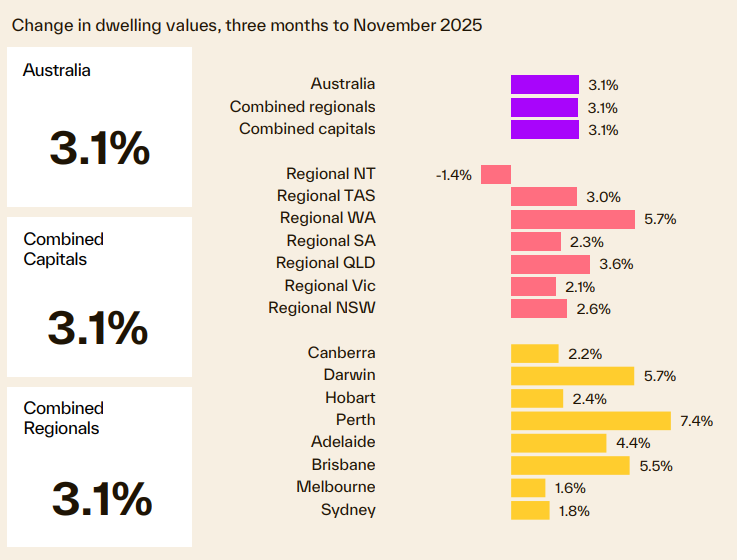


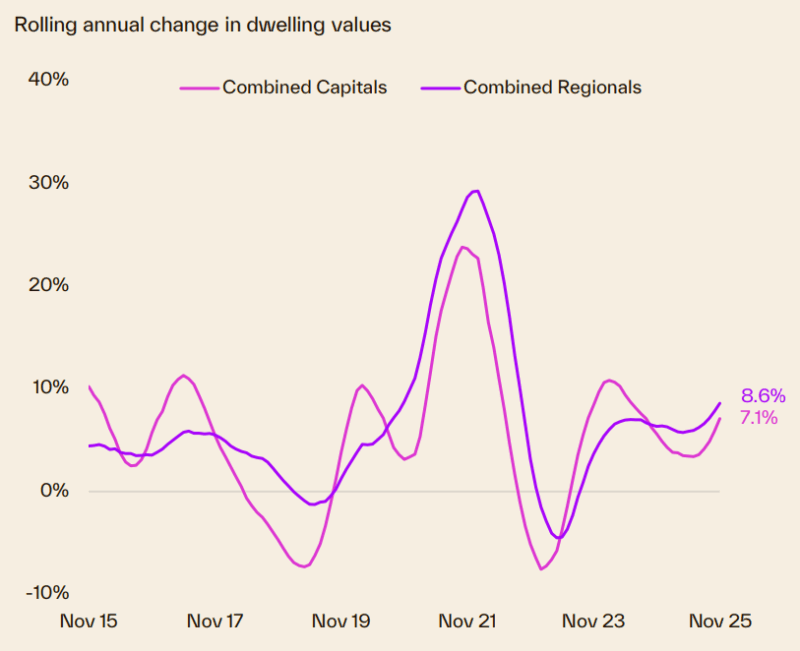
Our capital city markets are fragmented
Our housing markets are fragmented, with each state performing differently depending on local economic and market factors.
For quite some time, the lower quartile across all capital cities has shown stronger housing value growth; now the middle 50% of the market is performing strongly.
The following chart shows how various price segments of each capital city market are performing differently.

Each State is running its own race
One star performer was Brisbane, where property values increased 12.8% over the last year and are currently at a record high.

- Perth property values are up 13.1% over the year and are currently at a new record high.

- Sydney property values increased 5.1% over the past year and are currently at a new record high.

- Melbourne property values are up 0.3% in November, rose 4.2% over the year, but are still -0.9% below the record high seen in March 2022.

- In the previous darling of the housing markets, Hobart, house prices are -6.9 % below their record highs recorded in March 2022.

Here's how the Adelaide property market performed.

- Dwelling values in Canberra increased 4.2% over the last year.
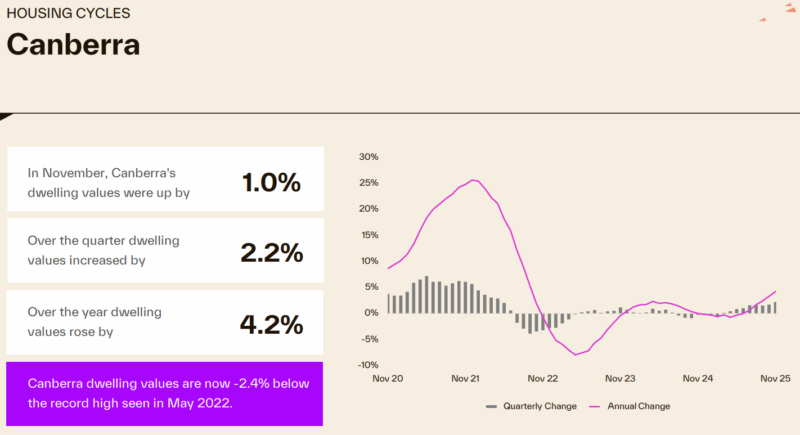
- The Darwin housing market has performed strongly, increasing 17% over the year and is currently at a new record high.

Here's how many properties are for sale at the moment
- The rolling 28-day count in national new listings peaked over the four weeks to November 9th at 44,074 and has trended lower as the spring selling season comes to a close.
- Over the four weeks to November 30th, national new listings levels were roughly in line with this time last year (0.6%) but -5.3% below the historic five-year average.
- The problem is that very few are A Grade homes or investment grade properties. Owners of quality properties are still holding onto them.
- Over the four weeks to November 30th, Cotality observed 130,047 properties for sale nationally, down -14.0% from the total number of listings seen this time last year.
- While new listings have trended roughly in line with historic averages since mid-September, strong sales activity has seen total advertised supply remain around -18% below the levels usually seen through spring.

Transaction volumes
- Cotality estimates that 49,279 homes transacted through November, taking the national 12-month rolling estimate of sales to 551,216.
- With sales activity across the combined capitals up 1.5% from this time last year and 6.9% above the previous five-year average, most capital cities are recording above-average levels of annual sales activity.
- Brisbane is the exception, with the count of sales down -1.1% compared to the previous five-year average and -3.7% from this time last year.
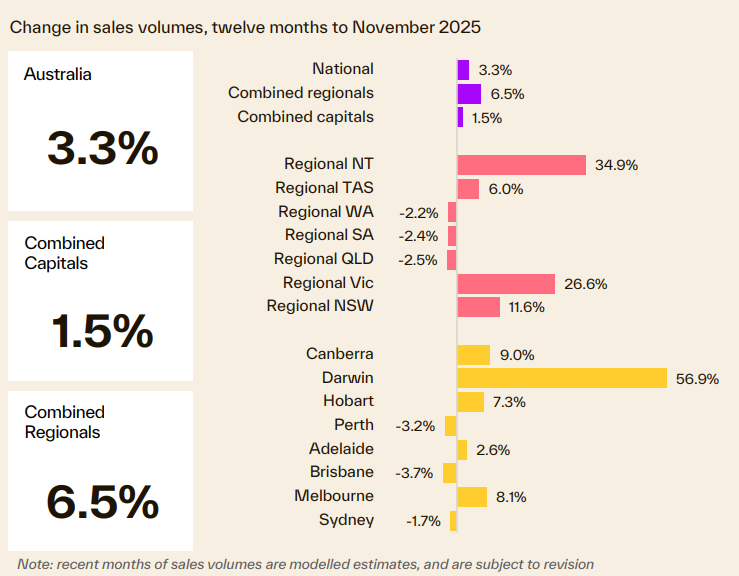

It's taking longer to sell a home.
- While the median selling time has increased slightly over the month nationally, at 27 days, the median time on market over the three months to November is in line with the same time last year.
- Results are more varied across the capitals and regions.
- Compared to this time last year, Darwin (37 days), Canberra (36 days), Melbourne (29 days), Perth (9 days) and Sydney (29 days) all saw faster selling times, while properties in Brisbane (19 days) and Hobart (27 days) took longer to transact.


Vendor Discounting
- Discounting rates across the combined capitals have held below the 3% mark over the past three months, with the 2.86% median discount recorded over the three months to November tied as the lowest since May 2021.
- Regional vendors are also offering smaller discounts to secure a sale.
- The median regional vendor discount has shrunk from 3.8% in Q1, to 3.2% over the three months to November.


Auction clearance rates
- Auction clearance rates across the combined capitals fell to their lowest point since early June over the week ending November 30th, with just 60.9% of the 3,427 auctions held reporting a successful result.
- This saw the four-week average success rate fall to 63.2%, down from a recent high of 70.0% over the 28 days to September 21st.
- Sydney (61.6%) saw the largest decline in average clearance rates among the auction capitals, followed by Melbourne (63.3%) down 5.4 and 2.6 percentage points respectively compared to the start of November.
- We update the weekly auction clearance results here each week.

We're still experiencing a rental market crisis in Australia.
- The annual rate of growth in national rents continued to tick higher for the sixth consecutive month, with rents up 5.0% over the year to November.
- Most capitals have recorded an acceleration in the annual pace of rental growth through the second half of the year.
- Adelaide is the exception, with its rental growth rate easing from 4.7% over the year to May, to 3.7% over the 12 months to November.


- With growth in values continuing to outpace the change in rents, national gross rental yields continued to compress in November to 3.58% —the lowest gross yield since October 2022 (3.57%).
- Across the capitals, Hobart (4.3%) is the only capital recording an increase in yields, compared to this time last year, up 9 basis points.
- Sydney has seen rental yields remain relatively steady at 3.0%, while Darwin (6.3%) reported the largest decline, down 55 basis points.
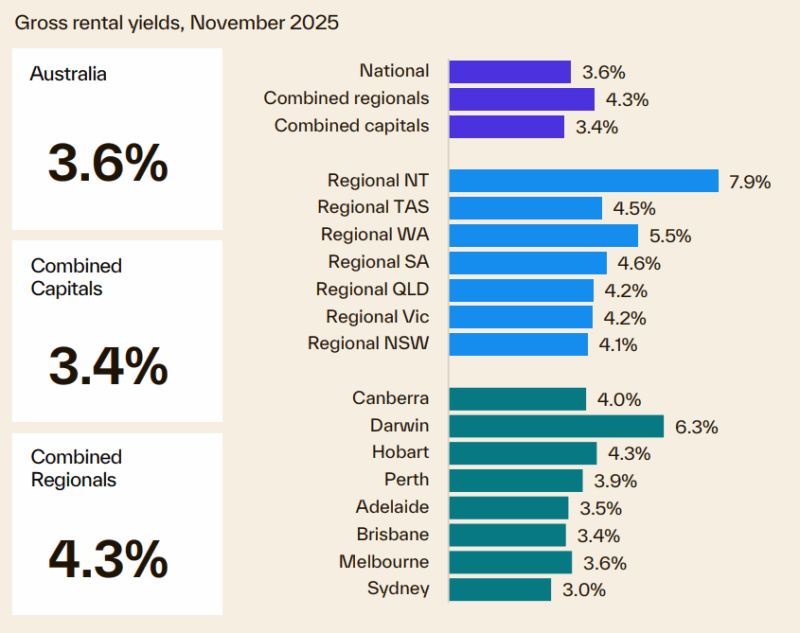

Dwelling approvals and housing credit
- The trend in dwelling approvals remains on shaky footings with the number of approvals falling -6.4% in October, with house approvals down 2.0% and the more volatile unit segment down 12.1%.
- Feasibility continues to be an ongoing challenge across the construction sector following a significant rise in cost over the past five years, along with labour supply constraints and ongoing competition with the public infrastructure sector, compressing profit margins.
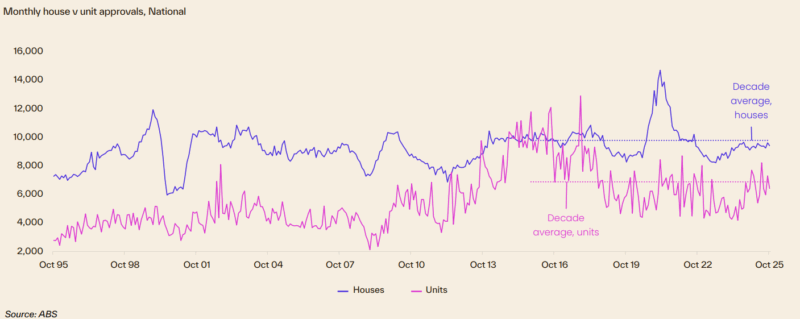
Finance and Lending
- Both the volume and value of new home loan commitments rose sharply over the September quarter, up 6.4% and 9.6% respectively compared to Q2.
- The rise saw the total value of new financing reach its highest level on record with $98 billion in residential mortgage commitments over the quarter.
- Investor activity drove the increases in both volume and value, up 13.6% and 17.6% respectively, while new owner occupier lending saw a smaller 2.0% lift in volume and 4.7% rise in value.

- First home buyers also recorded a rise in both the volume (+2.3%) and value (1.1%) of new financing over the quarter, albeit much milder relative to investors and subsequent owner occupiers.
- This saw first home buyers, as a share of new owner-occupier lending, trend lower to 28.3%.
- First home buyer lending will likely lift through Q4, with the expansion of the 5% Deposit Scheme, introduced on October 1st , expected to deliver a temporary boost for first home buyer demand.


Source of charts:Cotality Monthly Housing Chart Pack, December 2025














